Rating of the TOP-15 network switches of 2022: the principle of operation and an overview of the best models
Network switches connect several computer devices into one or more networks. What are the criteria for choosing this device, what should you pay special attention to. Specifications, strengths and weaknesses of the most popular devices.
network switches, unlike hubs, forward packets in a targeted manner, being generally more efficient devices.
Thanks to this and affordable cost, the former have practically ousted the latter from the market.
In this review, we will consider what a switch is, the criteria for choosing network equipment of this type, which models on the market today are the best.
Rating TOP-15 best network switches
| Place | Model | |
|---|---|---|
| Best Models with 4-5 Ports | ||
| #1 | TP-LINK LS1005G | |
| #2 | TP-LINK TL-SG105 | |
| #3 | ZYXEL GS1200-5 | |
| #4 | D-link DGS-1005D/I3 | |
| #5 | ZYXEL GS-105B V3 | |
| Switches with 6-8 ports | ||
| #1 | Cisco SG110D-08 | |
| #2 | Cisco SG250-08 | |
| Top models with 16 ports | ||
| #1 | Cisco SF110-16 | |
| #2 | Cisco SF110D-16 | |
| #3 | ZYXEL GS1300-18HP | |
| Enterprise models with 24-26 ports | ||
| #1 | Cisco SG220-26 | |
| #2 | Cisco SF220-24 | |
| #3 | Mikrotik CSS326-24G-2S+RM | |
What is a switch?
Switches transmit data directly to recipients, which has a positive effect on network performance and security.
Switch Selection Criteria
Network switching equipment of this class is characterized by an impressive number of parameters. Let's analyze the most important of them:
- Number of ports.
Switches with 5 to 48 ports are available on the market.
Models with a small number of RJ-45 connectors are suitable for small local area networks at home and in the office.
It is reasonable to purchase switches for 20 or more ports with serious expansions. - network model.
Almost all available unmanaged switches are layer 2.
Level 3 switches have a range of customizable features.
Expensive transport models are referred to the fourth level with the distribution of data flow, taking into account the intellectual component. - MAC address table.
The capacity of the MAC address table should be calculated in advance, taking into account the potential expansion of the network.
Lack of entries in the address table slows down data transfer. - Transfer rate.
This parameter is the base, and in fact the maximum port speed.
Some switches have ports with different speed modes or combinations. - internal throughput.
An important characteristic declared by the manufacturer.
The user is required to compare it with the external bandwidth.
If the first is less than the second, under loads, freezes and slowdown of the equipment are possible.
Best Models with 4-5 Ports
it the best option for organizing a network in an apartment or house with several desktop computers or laptops.
Rating of TOP-5 switches for 4-5 ports based on customer reviews and ratings.
TP-LINK LS1005G
The five-port desktop switch TP-LINK LS1005G allows you to connect up to five personal computers into a single network at the highest speed.
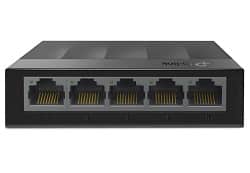
Thanks to this function, no additional manipulations are required when working with the switch.
The components of the presented network equipment are reliably protected from external influences by a reliable metal case.
The device is designed for a long service life.
Technical specifications:
- data transfer rate - 1 Gbps;
- throughput - 10 Gbps;
- MAC address table - 2048 entries;
- network standards - IEEE 802.1p, Jumbo Frame, MDI / MDIX auto-detection;
- control option - unmanaged;
- overall dimensions - 90? 23? 72mm.
Advantages
- compact dimensions;
- high connection speed;
- ease of setup and connection;
- does not heat up during operation.
Flaws
- light weight affects stability;
- no gigabit patch cord included.
TP-LINK TL-SG105
Switching equipment TP-LINK TL-SG105 allows you to easily connect up to four users to the network, whether it be an apartment or a small office.
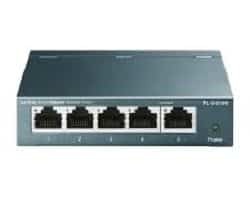
Among the many functions and capabilities of the switch, one can single out the tracking of passing traffic, network monitoring from a computer, technology for recognizing disconnection from the network or idle time.
The high bandwidth of the equipment will allow you to exchange data at the highest speed.
Technical specifications:
- data transfer rate - 1 Gbps;
- throughput - 10 Gbps;
- MAC address table - 2048 entries;
- network standards - IEEE 802.1p, Jumbo Frame, MDI / MDIX auto-detection;
- control option - unmanaged;
- overall dimensions - 100? 25? 98 mm.
Advantages
- affordable price;
- gigabit Ethernet ports;
- does not require complex manipulations with the settings;
- reliable metal case;
- nice appearance.
Flaws
- power connector and Ethernet ports on opposite sides of the case;
- mode and power indicators on cable ports;
- no ground contact.
ZYXEL GS1200-5
The ZYXEL GS1200-5 model in a compact package and a set of five interfaces will allow you to effortlessly combine existing network equipment into a local network.
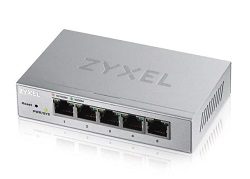
The total internal throughput is 10 Gbps.
The operating configuration is configured through an intuitive web interface.
The compact managed device is perfect for organizing or scaling a local network at home and in a small office.
The power consumption of the model does not exceed 2.6 W.
Technical specifications:
- data transfer rate - 1 Gbps;
- throughput - 10 Gbps;
- MAC address table - 2048 entries;
- network standards - IEEE 802.1q / 802.3ad / 802.1p, Jumbo Frame, MDI / MDIX auto-detection;
- control option - level 2;
- overall dimensions - 121? 26? 75mm.
Advantages
- high quality materials and assembly;
- support for full duplex with auto-switching to it;
- indication on each port;
- high switching performance;
- port mirroring.
Flaws
- many settings;
- case heating is present;
- overpriced in comparison with analogues.
D-link DGS-1005D/I3
The DGS-1005D/I3 unmanaged D-link switch belongs to the line of SOHO class models, characterized by uninterrupted operation in a small network service environment.
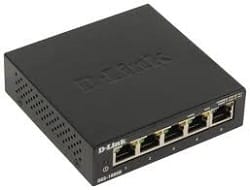
The equipment can be installed on the table and thanks to the presence of holes for mounting on the wall.
An external adapter is responsible for powering the device.
The device can be operated at a temperature of 0-40 degrees and at a maximum humidity of 90 percent. The power consumption of the device does not exceed 3.9 watts.
Technical specifications:
- data transfer rate - 1 Gbps;
- throughput - 10 Gbps;
- MAC address table - 2048 entries;
- network standards - IEEE 802.1p, Jumbo Frame, MDI / MDIX auto-detection;
- control option - unmanaged;
- overall dimensions - 140? 28? 85mm.
Advantages
- quick and easy connection;
- high speed channels;
- noiselessness of work;
- metal case with the possibility of mounting on the wall.
Flaws
- the power cable is inconveniently located;
- the rubber feet slide off the seats.
ZYXEL GS-105B V3
Network equipment ZYXEL GS-105B V3 unmanaged type is able to network multiple computers to provide them with high-speed Internet access.
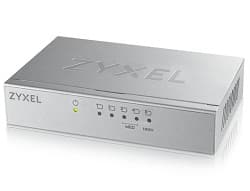
The small dimensions of the case make it possible to install the device in any suitable place, for example, on top of the system unit.
Rubber feet provide maximum stability of the device. The power consumption of the equipment is 3 W.
Technical specifications:
- data transfer rate - 1 Gbps;
- throughput - 10 Gbps;
- MAC address table - 2048 entries;
- network standards - Jumbo Frame, MDI / MDIX auto-detection;
- control option - unmanaged;
- overall dimensions - 121? 26? 75mm.
Advantages
- stability and reliability of work;
- lack of heating of components;
- compact dimensions;
- cute design.
Flaws
- high price;
- the relative complexity of the setup.
Switches with 6-8 ports
Such devices will allow you to organize a network with quick access to shared files and the Internet in a small office.
An overview of the best network switches for 6-8 ports in terms of price and quality.
Cisco SG110D-08
The Cisco SG110D-08 switching device in a reliable compact case can be used not only to connect computers, but also other related devices.

The equipment belongs to the class of unmanaged switches, it does not require additional training.
Eight connectors on board the device support speeds up to 1 Gb / s each.
The device has an optimal internal bandwidth, supports the main standards, the Store and forward switching method. An external power adapter is included in the package.
Technical specifications:
- data transfer rate - 1 Gbps;
- throughput - 16 Gbps;
- MAC address table - 4096 entries;
- network standards - IEEE 802.1p, Jumbo Frame, MDI / MDIX auto-detection;
- control option - unmanaged;
- overall dimensions - 160? thirty ? 103 mm.
Advantages
- simple installation and connection;
- high speed without failures;
- small size and weight;
- quality materials and assembly.
Flaws
- for installation in a cabinet;
- sensitivity to spring-loaded contacts on cable connectors.
Cisco SG250-08
Switching device with eight ports on board is the best solution for organizing or scaling a local network that unites work computers and other network peripherals in a small office.

The total internal throughput is 16 Gbps.
The Cisco SG250-08 supports the CLI/HTTP/HTTPS/RMON/SNMP/SSH/TFTP/telnet protocols.
The equipment belongs to the class of managed switches, it stands out for its wide functionality and stability.
The model can be placed on a table. The power consumption of the device is approaching 7.6 watts.
Technical specifications:
- data transfer rate - 1 Gbps;
- throughput - 16 Gbps;
- MAC address table - 8192 entries;
- network standards - IEEE 802.1q / 802.3ad / 802.1p / 802.1d / 802.1s, MDI / MDIX auto-detection;
- control option - level 2;
- overall dimensions - 160? thirty ? 128mm.
Advantages
- high reliability;
- performance;
- support for current network standards;
- everything you need is included.
Flaws
- for installation in low-voltage cabinets;
- industrial utility design;
- high cost of equipment.
ZYXEL GS-108Bv3
The ZYXEL GS-108B v3 model, being an unmanaged switch, is able to combine several peripheral devices with their network interaction and Internet access.
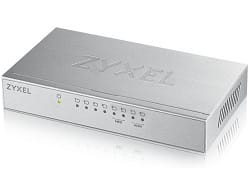
Compact dimensions allow you to place the device on top of the system unit.
Computers can be connected to the device to provide them with speeds up to 1 Gbps.
The total internal throughput of the model is 16 Gbps, the packet service rate is 1.4 Mpps. The equipment supports the most up-to-date communication protocols.
Technical specifications:
- data transfer rate - 1 Gbps;
- throughput - 16 Gbps;
- MAC address table - 4096 entries;
- network standards - IEEE 802.3az, Jumbo Frame, MDI / MDIX auto-detection;
- control option - unmanaged;
- overall dimensions - 155? 26? 85mm.
Advantages
- gigabit ports;
- ease of maintenance;
- lack of strong heating;
- noiselessness of work;
- powerful power supply.
Flaws
- too small openings of canopies on the wall;
- too long power cable;
- dim LED indication;
- non-standard default password.
TP-LINK TL-SG108
The TP-LINK TL-SG108 model allows you to connect to a local network in an office or home with an increase in the speed and quality of a network connection for up to eight users.
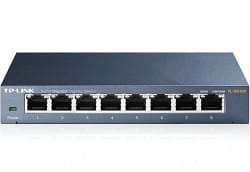
The switch's extensive functionality allows you to monitor the network from a computer, take advantage of outage or idle detection technology (saving up to 72 percent of electrical energy) and exchange data at the highest speed.
Technical specifications:
- data transfer rate - 1 Gbps;
- throughput - 16 Gbps;
- MAC address table - 4096 entries;
- network standards - IEEE 802.1p, Jumbo Frame, MDI / MDIX auto-detection;
- control option - unmanaged;
- overall dimensions - 158? 25? 101mm.
Advantages
- reliable metal case;
- the possibility of mounting on the wall;
- no speed drops;
- light weight;
- priority traffic support.
Flaws
- power is connected on the opposite side of the connectors;
- no power indicator on the side of the power input;
- high price.
Top models with 16 ports
Switches with 16 ports will allow you to combine a server and many computer devices in a fairly large office.
Cisco SF110-16
The presented Cisco SF110-16 model, equipped with 16 ports supporting data transfer at speeds up to 100 Mbps, will allow you to combine devices in the office or at home into a single network.
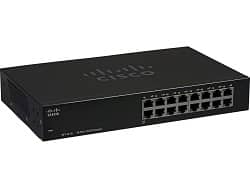
The device does not require self-configuration when connecting and putting it into operation.
The device supports the Store and forward switching type and is recommended for rack mounting.
Suitable for indoor operation with ambient temperature 0-40 degrees and relative humidity 5-90 percent.
Technical specifications:
- data transfer rate - 100 Mbps;
- throughput - 3.2 Gbps;
- MAC address table - 8192 entries;
- network standards - IEEE 802.1p, Jumbo Frame, MDI / MDIX auto-detection;
- control option - unmanaged;
- overall dimensions - 279? 44? 170mm.
Advantages
- rich equipment;
- high-quality assembly and materials;
- built-in power supply;
- stability and speed.
Flaws
- heating during operation;
- large dimensions and weight;
- expensive model.
Cisco SF110D-16
Switching device for commercial organizations Cisco SF110D-16 makes it possible to combine user computers into a local network for data exchange and Internet access.

This means that the equipment is set up and ready for use.
The device has a desktop version, its optimal dimensions do not require much space.
The device receives electricity from a standard network using an external power adapter.
16 ports on board the device allow you to connect many devices, create a local area network with high internal bandwidth.
Technical specifications:
- data transfer rate - 100 Mbps;
- throughput - 1.6 Gbps;
- MAC address table - 8192 entries;
- network standards - MDI / MDIX auto-detection;
- control option - unmanaged;
- overall dimensions - 279? 44? 170mm.
Advantages
- ease of installation and configuration;
- quality performance;
- powerful power supply;
- decent speed.
Flaws
- impressive dimensions and weight;
- thin cord of the power adapter.
ZYXEL GS1300-18HP
Switch ZYXEL GS1300-18HP in a reliable and relatively compact package will easily create an extensive network of 18 computers and other digital devices.
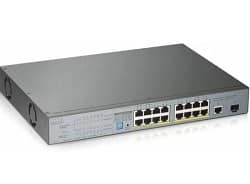
All 16 ports support PoE, allowing you to connect video cameras, VoIP devices to the network with their simultaneous power supply.
The total internal bandwidth of 36 Gbps will eliminate potential lags at maximum load.
The unmanaged switch is designed to be rack-mounted using the included mounting hardware.
Technical specifications:
- data transfer rate - 1 Gbps;
- throughput - 36 Gbps;
- MAC address table - 8192 entries;
- network standards - IEEE 802.1p;
- control option - unmanaged;
- overall dimensions - 330? 44? 230 mm.
Advantages
- high-speed gigabit ports;
- additional overload protection on Ethernet ports and power supply;
- four extended range ports, gigabit uplink;
- fast commissioning.
Flaws
- noisy non-switchable coolers;
- unremarkable appearance.
Enterprise models with 24-26 ports
These devices are a completely different level of equipment, usually for professional use.
Cisco SG220-26
The corporate switching system is recommended for installation in office premises in order to create a small network for data exchange between the involved equipment.

The switch has 26 slots with a base data rate of up to 1000 Mbps.
The equipment is equipped with two SFP connectors. The device belongs to the category of managed type switches with the possibility of additional configuration if necessary.
The device is mounted on a rack. Appropriate fasteners are included.
Technical specifications:
- data transfer rate - 1 Gbps;
- throughput - 52 Gbps;
- MAC address table - 8192 entries;
- network standards - EEE 802.3z, Jumbo Frame, IEEE 802.3az/802.3u/802.3ab/802.3x/802.1q;
- control option - managed;
- overall dimensions - 440? 200? 44mm.
Advantages
- high data transfer rate;
- support for current network standards;
- quiet work;
- SFP connectors.
Flaws
- impressive dimensions;
- complicated setup;
- lack of fans (may heat up during operation).
Cisco SF220-24
The Cisco SF220-24 switch in a reliable housing protected from external influences will provide connection to a single network of computers, surveillance cameras and other devices at minimal cost.

The switching option used is Store and forward. This instrument is designed to be placed on a stand.
The power supply is integrated into the case. The declared power consumption parameter is 9.2 W, on board there are 26 ports with two SFP connectors.
Technical specifications:
- data transfer rate - 100 Mbps;
- throughput - 8.8 Gbps;
- MAC address table - 8192 entries;
- network standards - IEEE 802.1q / 802.3ad / 802.1p / 802.1d / 802.1s, Jumbo Frame, MDI / MDIX auto-detection;
- control option - level 2;
- overall dimensions - 440? 44? 201mm.
Advantages
- support for modern network standards;
- ease of placement on the rack;
- SFP ports for bulk traffic;
- does not overheat at maximum load.
Flaws
- high price;
- large size and weight;
- amateur design.
Mikrotik CSS326-24G-2S+RM
Switching equipment designed to combine many peripheral devices will provide stable transmission and reception of information between devices at the highest speed.

The managed type switch allows you to adapt the parameters taking into account the further use of the equipment.
On board the device there are 26 connectors for connecting peripherals, two SFP-type ports. The peak power consumption of this device does not exceed 9.31 watts.
Technical specifications:
- data transfer rate - 1 Gbps;
- throughput - 88 Gb / s;
- MAC address table - 16384 entries;
- network standards - IEEE 802.1q;
- control option - level 2;
- overall dimensions - 440? 44? 144mm.
Advantages
- simple but informative web interface;
- high-speed gigabit ports;
- support for SFP modules;
- huge bandwidth.
Flaws
- atypical settings;
- no console port;
- indication only on the link and activity.
Reviews
This review has no replies yet.
Conclusion
- network switch (switch) is equipment designed to create one or more networks with a combination of several computers and other peripheral devices.
- The most important parameter of this switching equipment is the number of ports on board.
Their number is related to the number of expected physical network connections. - Among other features when choosing, you should pay attention to the network model of the device, the capacity of the MAC address table, data transfer rate and internal bandwidth.
Useful video
From this video you will learn what is the difference between a router, a switch and a hub:


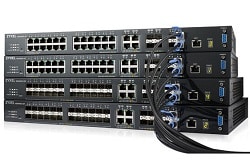 Models with a small number of RJ-45 connectors are suitable for small local area networks at home and in the office.
Models with a small number of RJ-45 connectors are suitable for small local area networks at home and in the office.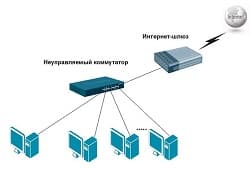 An important characteristic declared by the manufacturer.
An important characteristic declared by the manufacturer.